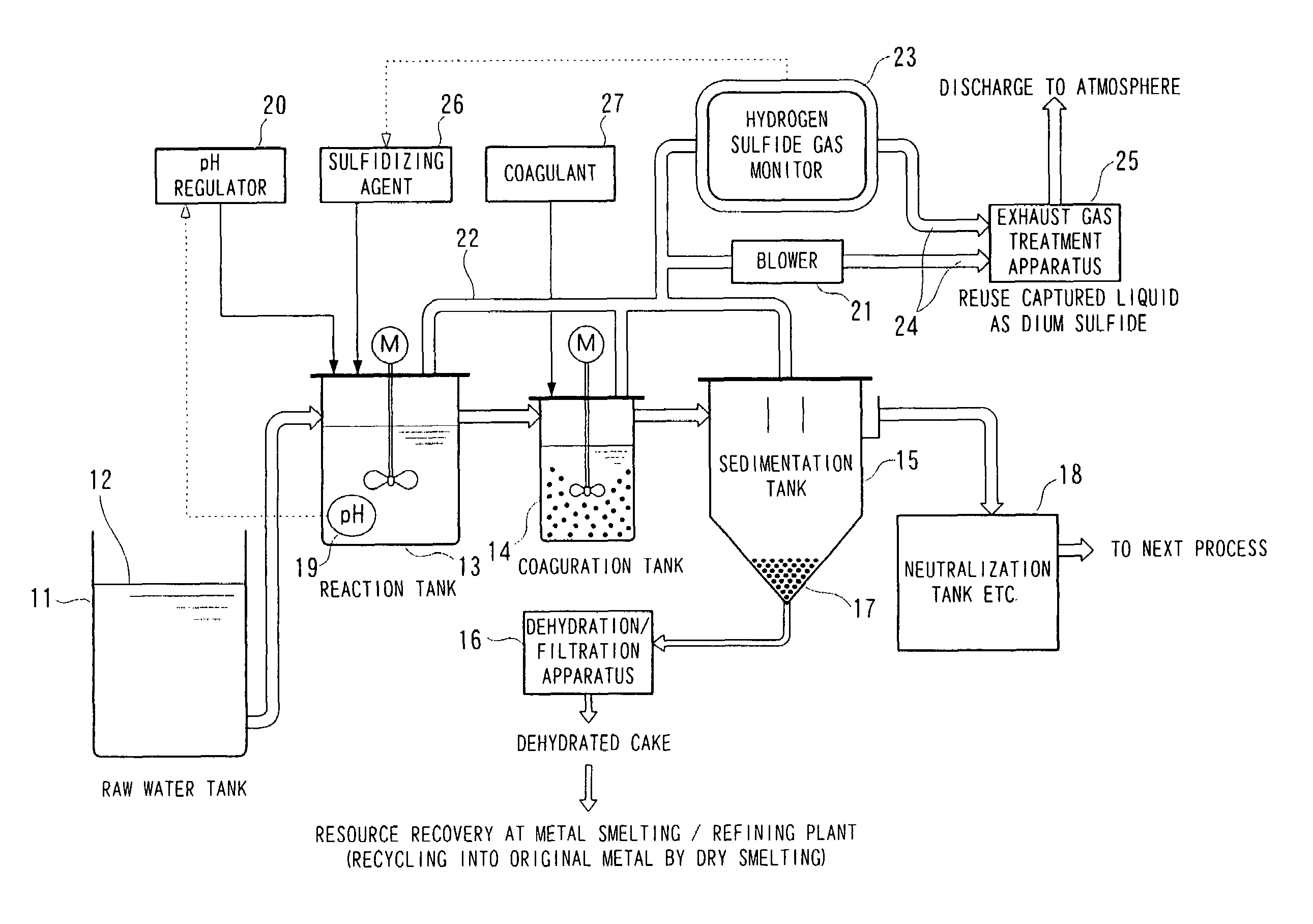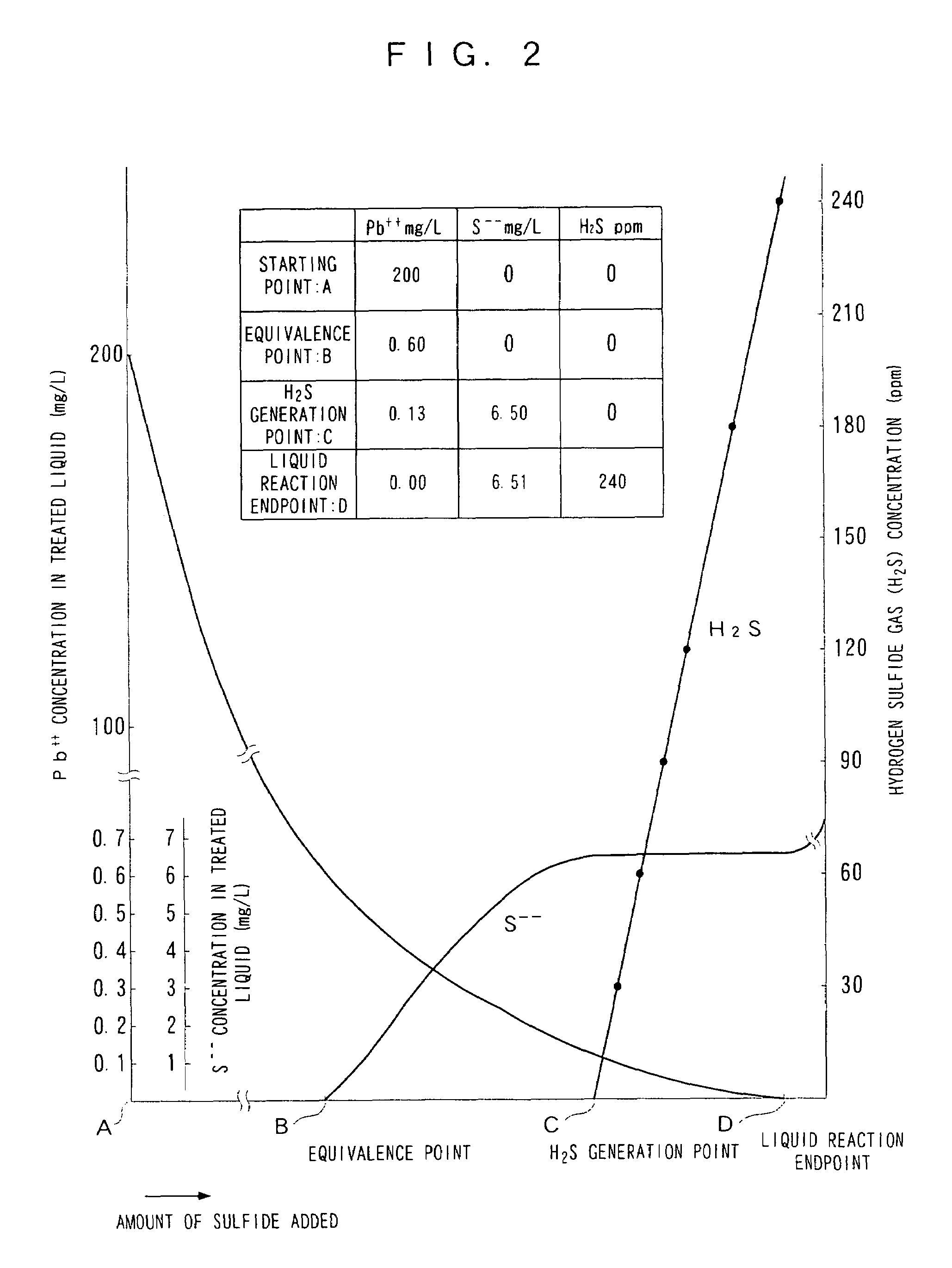Method for treating heavy-metal-containing wastewater using sulfidizing agent
a technology of heavy metals and sulfide agents, which is applied in the direction of water/sewage treatment by degassing, separation processes, water/treatment water, etc. it can solve the problems of uneconomical recycling, uneconomical recycling, adverse effects on ecology and human health, etc., and achieves reduced sludge volume, reduced impurities, and high purity
- Summary
- Abstract
- Description
- Claims
- Application Information
AI Technical Summary
Benefits of technology
Problems solved by technology
Method used
Image
Examples
example 1
[0135]Using the continuous treatment apparatus shown in FIG. 4, the pH of standard lead wastewater (2 liters) containing 200 mg / L of lead ions was adjusted to 3.5 in the reaction tank 13. A set amount of sodium sulfide (Na2S) as a sulfidizing agent was then added continuously at a rate of 1.1 mg / min to the pH-adjusted wastewater, thus carrying out sulfide treatment. The hydrogen sulfide gas was monitored after being diluted by a dilution factor of 12 times. The results are shown in FIG. 5. In FIG. 5, the horizontal axis shows the hydrogen sulfide gas concentration on a logarithmic scale, and the vertical axis shows the residual Pb concentration and the residual sulfide concentration.
[0136]In FIG. 5, it can be seen that although the treated liquid contained 200 mg / L of Pb ions initially as mentioned above, when hydrogen sulfide gas was detected at a concentration of 30 ppm, the residual Pb ion concentration in the treated liquid had dropped greatly down to 0.09 mg / L.
[0137]Moreover, a...
example 2
[0139]Using the continuous treatment apparatus shown in FIG. 4 as in Example 1, the pH of standard copper wastewater (2 liters) containing 200 mg / L of copper ions was adjusted to 1.6. A set amount of sodium sulfide (Na2S) was then added continuously at a rate of 1.1 mg / min to the pH-adjusted wastewater, thus carrying out sulfide treatment. The hydrogen sulfide gas was monitored after being diluted by a dilution factor of 12 times. The results are shown in FIG. 6.
[0140]In FIG. 6, it can be seen that although the treated liquid contained 200 mg / L of Cu ions initially as mentioned above, when hydrogen sulfide gas was detected at a concentration of 30 ppm, the residual Cu ion concentration in the treated liquid had dropped greatly down to 4.0 mg / L. Moreover, at this time, the residual sulfide concentration was 19.5 mg / L, which was 1 / 5.2 of the stoichiometric amount. The amount of sulfide remaining in the liquid after the treatment was thus very low.
[0141]In the case of further continuin...
example 3
[0142]Using the continuous treatment apparatus shown in FIG. 4 as in Example 1, the pH of nickel-containing wastewater (2 liters) containing 200 mg / L of Ni ions was adjusted to 8.5. A set amount of sodium sulfide (Na2S) was then added continuously at a rate of 1.1 mg / min to the pH-adjusted wastewater, thus carrying out sulfide treatment. The hydrogen sulfide gas was monitored after being diluted by a dilution factor of 12 times. The results are shown in FIG. 7.
[0143]As shown in FIG. 7, the residual Ni concentration had dropped down to 3 mg / liter when the hydrogen sulfide gas concentration was 90 ppm. Note that the residual Ni concentration increased when the hydrogen sulfide gas concentration increased from 90 ppm to 120 ppm and then 180 ppm, and it is thought that this is because nickel persulfide was produced and redissolution occurred.
PUM
| Property | Measurement | Unit |
|---|---|---|
| concentration | aaaaa | aaaaa |
| concentration | aaaaa | aaaaa |
| concentration | aaaaa | aaaaa |
Abstract
Description
Claims
Application Information
 Login to View More
Login to View More - R&D
- Intellectual Property
- Life Sciences
- Materials
- Tech Scout
- Unparalleled Data Quality
- Higher Quality Content
- 60% Fewer Hallucinations
Browse by: Latest US Patents, China's latest patents, Technical Efficacy Thesaurus, Application Domain, Technology Topic, Popular Technical Reports.
© 2025 PatSnap. All rights reserved.Legal|Privacy policy|Modern Slavery Act Transparency Statement|Sitemap|About US| Contact US: help@patsnap.com



